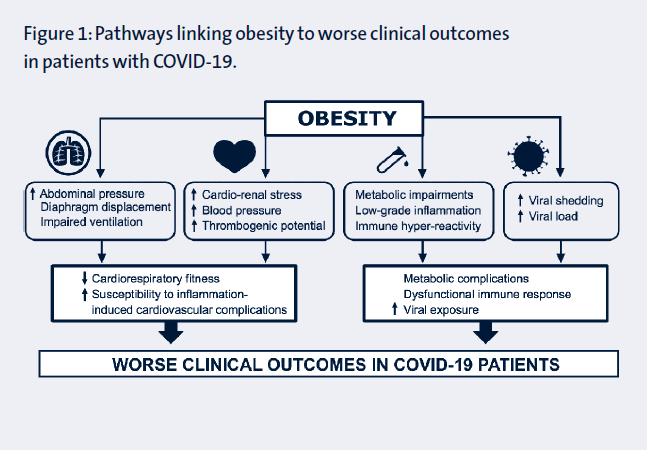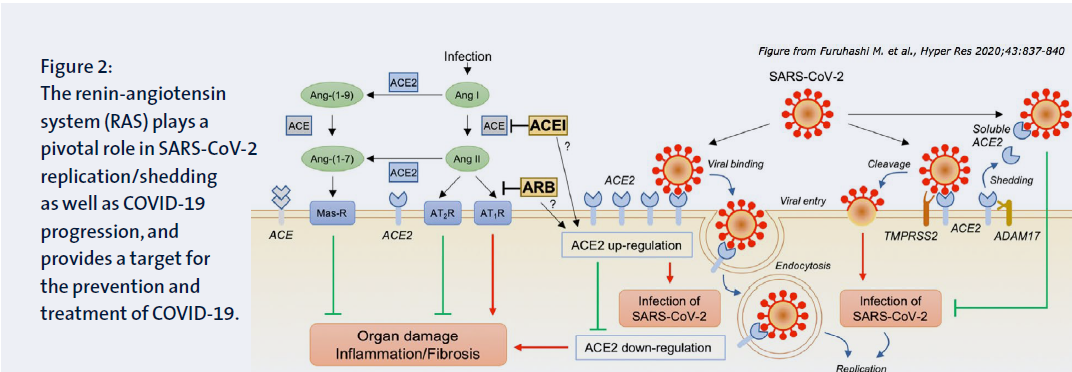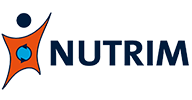Obesity, impaired cardio metabolic health and COVID-19: a pivotal role of the renin-angiotensin system
Division 1: Obesity, Diabetes & Cardiovascular Health
Department of Human Biology
Background
The renin-angiotensin system in obesity: metabolic and hemodynamic effects
Our research efforts have mainly focused on the metabolic implications of adipose tissue dysfunction in people with obesity. We investigated the metabolic and hemodynamic effects of the renin-angiotensin system (RAS) in obesity for more than 15 years, showing that angiotensin II (Ang II), the main effector peptide of the RAS, contributes to impairments in adipose tissue and skeletal muscle metabolism and blood flow in humans (1-4), thus contributing to the development of insulin resistance. In several follow-up studies, amongst other findings, we discovered that interference with the RAS, using the angiotensin II type 1 (AT1) receptor blocker (ARB) valsartan, alters adipocyte morphology, lowers adipose tissue inflammation, improves insulin sensitivity and enhances beta-cell function in humans (5, 6). These studies have led to important contributions in our understanding of the contribution of the RAS to obesity-related metabolic perturbations.

Major Breakthroughs
Obesity and COVID-19: Involvement of the renin-angiotensin system
Obesity not only increases the risk of many non-communicable diseases such as type 2 diabetes and cardiovascular diseases, but also seems to impact communicable diseases. Recent evidence indicates that obesity is an independent risk factor for worse clinical outcomes in patients with coronavirus disease 2019 (COVID-19) (Figure 1). Adopting a healthy lifestyle and adequate management of obesity and related complications is crucial to lower the risk of SARS-CoV-2 infection and poor outcomes in COVID-19 (7). Angiotensin converting enzyme-2 (ACE2) is the cell-surface receptor enabling cellular entry of the severe acute respiratory syndrome coronavirus 2 (SARS-CoV-2). The abundance of ACE2 is high in adipose tissue, rendering adipose tissue a potential SARS-CoV-2 reservoir, thereby contributing to the viral spread and cytokine storm typically observed in COVID-19 patients with obesity (7). ACE2 is part of the RAS.
The RAS not only regulates blood pressure, but also mediates pro-inflammatory signaling, thrombotic processes and fibrosis via the AT1 receptor, thus contributing to pathological changes of organ structure and function. Hence, the ACE2 receptor and other components of the RAS have been suggested to play a pivotal role in SARS-CoV-2 replication/shedding as well as COVID-19 progression and may provide targets for the prevention and treatment of COVID-19 (Figure 2) (7, 8). Animal studies suggest that the polyphenolic compound resveratrol may influence ACE2 expression (9-11). We have recently analyzed tissue biopsies from a previously conducted randomized, placebo-controlled, crossover study, in which healthy obese men received resveratrol supplementation for 30 days (12). We found that resveratrol significantly lowers adipose tissue ACE2 expression. These findings suggest that resveratrol may aid to reduce the risk of severe clinical outcomes following SARS-CoV-2 infection in people with obesity.
Who is involved
A team effort
The research on obesity and the RAS is embedded within the Nutrition, Integrative Metabolism and Obesity NIMO lab, PI’s Prof. dr. Ellen Blaak and Dr. Gijs Goossens). We focus on the metabolic inter-organ crosstalk between the gut, adipose tissue, liver and skeletal muscle in the pathophysiology of obesity-related insulin resistance and metabolic complications.
Our team also explores the impact of (precision-based) dietary, exercise and pharmacological interventions, as well as modulation of environmental factors such as oxygen availability, on metabolic health in people with obesity, with healthy ageing as the ultimate goal. This is investigated at the whole-body, tissue and cellular level by integrating innovative human in vivo techniques, analyses in adipose tissue and skeletal muscle biopsies, and mechanistic experiments using human primary adipocytes and myotubes.

Users and collaborations
Profs. Marleen van Baak, Ellen Blaak and Wim Saris (Dept. of Human Biology, MUMC+) were closely involved in the studies performed to elucidate the metabolic and hemodynamic effects of the RAS in people with obesity.
We investigated metabolic fluxes across adipose tissue and studied the
importance of the RAS in adipose tissue blood flow regulation in humans in collaboration with Profs. Keith Frayn and Fredrik Karpe (University of Oxford, UK). Moreover, we explored the effects of ARB treatment on glucose homeostasis with the team of Prof. Michaela Diamant (Amsterdam UMC), and joined forces with Prof. Karine Clément (Paris, France) to unravel ARB effects on inflammation. In parallel, we started a new research line to examine the importance of tissue oxygenation in cardiometabolic health, in collaboration with Dr. Merima
Čajlaković (Graz, Austria), and developed/validated a novel technique to continuously monitor tissue oxygen partial pressure in vivo in humans (13-15). In addition, as a Chair of the Scientific Advisory Board of the European Association for the Study of Obesity (EASO), Gijs Goossens was actively involved in
the writing of several collaborative Opinion/Perspective articles on obesity and COVID-19 with several international experts and EASO colleagues (7, 16, 17). The studies examining the effects of resveratrol and ARB treatment on tissue ACE2 were performed in close collaboration with Dr. Marlies de Ligt and Prof. Matthijs
Hesselink (Dept. of Nutrition and Movement Sciences, MUMC+).
Scientific impact/Research quality
For the work our team performed together with our (inter) national collaborators to explore the impact of obesity, the RAS and oxygen partial pressure on glucose homeostasis in humans, Gijs Goosens has received several prestigious awards,
including the Young Investigator Award in Clinical Research from the European Association for the Study of Obesity (yearly awarded to most promising young researcher within Europe in the field of obesity) and the Rising Star Award from the European Foundation for the Study of Diabetes (yearly awarded to most promising young researcher within Europe in the field of diabetes). In addition, our recent work on the association between the gut microbiota and host metabolism has had substantial scientific impact.
Selection of publications
1. Goossens GH, Jocken JWE, Blaak EE. Sexual dimorphism in adipose tissue, skeletal muscle and liver metabolism - the impact on cardiometabolic health. Nat Rev Endocrinol 2021; 17: 47-66.
2. Goossens GH, Dicker D, Farpour-Lambert NJ, Frühbeck G, Mullerova D, Woodward E, Holm J-C. Obesity and COVID-19: a Perspective from the European Association for the Study of Obesity on Immunological Perturbations, Therapeutic Challenges and Opportunities. Obes Facts 2020; 13: 439-452.
3. Vogel MAA, Jocken JWE, Sell H, Hoebers N, Essers Y, Rouschop KMA, Cajlakovic M, Blaak EE, Goossens GH. Differences in Upper and Lower Body Adipose Tissue Oxygen Tension Contribute to the Adipose Tissue Phenotype in Humans. J Clin Endocrinol Metab 2018; 103: 3688-3697.
4. Goossens GH, Vogel MAA, Vink RG, Mariman E, van Baak MA, Blaak EE. Adipose tissue oxygenation is associated with insulin sensitivity independent of adiposity in obese men and women. Diabetes Obes Metab 2018; 20: 2286-2290.
5. Vink RG, Roumans NJ, Čajlaković M, Cleutjens JPM, Boekschoten MV, Fazelzadeh P, Vogel MAA, Blaak EE, Mariman EC, van Baak MA, Goossens GH. Diet-induced weight loss decreases adipose tissue oxygen tension with parallel changes in adipose tissue phenotype and insulin sensitivity in overweight humans. Int J Obes 2017; 41: 722-728.
6. Reijnders D*, Goossens GH*, Hermes GD, Neis EP, van der Beek CM, Most J, Holst JJ, Lenaerts K, Kootte RS, Nieuwdorp M, Groen AK, Olde Damink SW, Boekschoten MV, Smidt H, Zoetendal EG, Dejong CH, Blaak EE. Effects of gut microbiota manipulation by antibiotics on host metabolism in obese humans: a randomized double-blind placebo-controlled trial. Cell Metab 2016; 24: 63-74.
7. van der Zijl NJ, Moors CCM, Goossens GH, Hermans MM, Blaak EE, Diamant M. Valsartan improves beta-cell function and insulin sensitivity in subjects with impaired glucose metabolism: a randomized controlled trial. Diabetes Care 2011; 34: 845-851.
8. Goossens GH, Bizzarri A, Venteclef N, Essers Y, Cleutjens JP, Konings E, Jocken JWE, Čajlaković M, Ribitsch V, Clément K, Blaak EE. Increased adipose tissue oxygen tension in obese compared to lean men is accompanied by insulin resistance, impaired adipose tissue capillarisation and inflammation. Circulation 2011; 124: 67-76.
Societal impact
Gijs Goossens highly values the sharing of new insights with scientific colleagues, other health professionals and the general public and has been invited to present their work at many different (inter)national conferences (i.e. European and International Congress on Obesity) as well as at meetings with dieticians, general practitioners and specialists (Jaaroverzicht Obesitas platform, 3 Dec 2020; Werkgroep Deskundigheids-bevordering Huisartsen Limburg, 10 Dec 2020; Kenniscentrum Diëtisten Overgewicht en Obesitas, 12 Oct 2020). Our work has also been widely covered in the (inter)national media.
- Article in The Times (UK): “Call for obese people to be shielded in new outbreaks” (Sept 2020).
- FHML Research Stories: “Obesity and COVID-19” (18 Sept 2020).
- Interview De Telegraaf (7 Nov 2020): “COVID-19 valt zwaar”.
- Interview European Association for the Study of Obesity: “Obesity impacts NCDs and Communicable Disease too: ACE2 receptor in human adipose tissue” (12 Nov 2020).
- Broad national media coverage (radio, newspapers, social media) related to the media campaign that I have initiated around World Obesity Day (4 March 2020). This included news items on NPO Radio 1, EenVandaag, RTL Nieuws/Editie NL, and articles in AD, Metro, Zorgkrant, and De Limburger.
- Interview Maastricht UMC+ (‘Onze verhalen’): ‘Obesitas vergt een aanpak op maat’, 3 maart 2020.
- Artikel De Limburger: “Onderzoeker Maastricht UMC+ bepleit aanpak op maat bij obesitas” (3 maart 2020).
- Interview UMagazine (25 Feb 2021): “Obesitas en corona een gevaarlijk duo”.
References
1. Goossens GH, Blaak EE, Saris WH, van Baak MA. Angiotensin
II- induced effects on adipose and skeletal muscle tissue blood flow and lipolysis in normal-weight and obese subjects. J Clin Endocrinol Metab. 2004;89:2690-2696.
2. Goossens GH, Blaak EE, Arner P, Saris WH, van Baak MA. Angiotensin II: a hormone that affects lipid metabolism in adipose tissue. Int J Obes (Lond). 2007;31:382-384.
3. Goossens GH, McQuaid SE, Dennis AL, van Baak MA, Blaak EE, Frayn KN, et al. Angiotensin II: a major regulator of subcutaneous adipose tissue blood flow in humans.
The Journal of physiology. 2006;571:451-460.
4. Goossens GH, Jocken JW, Blaak EE, Schiffers PM, Saris WH, van Baak MA. Endocrine role of the renin-angiotensin system in human adipose tissue and muscle: effect of beta- adrenergic stimulation. Hypertension. 2007;49:542-547.
5. van der Zijl NJ, Moors CC, Goossens GH, Hermans MM, Blaak EE, Diamant M. Valsartan improves {beta}-cell function and insulin sensitivity in subjects with impaired glucose metabolism: a randomized controlled trial. Diabetes Care. 2011;34:845-851.
6. Goossens GH, Moors CC, van der Zijl NJ, Venteclef N, Alili R, Jocken JW, et al. Valsartan improves adipose tissue function in humans with impaired glucose metabolism: a randomized placebo-controlled double-blind trial. PLoS One. 2012;7:e39930.
7. Goossens GH, Dicker D, Farpour-Lambert NJ, Fruhbeck G, Mullerova D, Woodward E, et al. Obesity and COVID-19:
A Perspective from the European Association for the Study of Obesity on Immunological Perturbations, Therapeutic Challenges, and Opportunities in Obesity. Obes Facts. 2020;13:439-452.
8. Gheblawi M, Wang K, Viveiros A, Nguyen Q, Zhong JC, Turner AJ, et al. Angiotensin-Converting Enzyme 2: SARS-CoV-2 Receptor and Regulator of the Renin-Angiotensin System: C elebrating the 20th Anniversary of the Discovery of ACE2. Circ Res. 2020;126:1456-1474.
9. Kim EN, Kim MY, Lim JH, Kim Y, Shin SJ, Park CW, et al.
The protective effect of resveratrol on vascular aging by modulation of the renin-angiotensin system. Atherosclerosis. 2018;270:123-131.
10. Moran CS, Biros E, Krishna SM, Wang Y, Tikellis C, Morton SK, et al. Resveratrol Inhibits Growth of Experimental Abdominal Aortic Aneurysm Associated With Upregulation of Angiotensin-Converting Enzyme 2. Arterioscler Thromb Vasc Biol. 2017;37:2195-2203.
11. Oliveira Andrade JM, Paraiso AF, Garcia ZM, Ferreira AV, Sinisterra RD, Sousa FB, et al. Cross talk between angiotensin-(1-7)/Mas axis and sirtuins in adipose tissue and metabolism of high-fat feed mice. Peptides.
2014;55:158-165.
12. Timmers S, Konings E, Bilet L, Houtkooper RH, van de Weijer T, Goossens GH, et al. Calorie restriction-like effects of 30 days of resveratrol supplementation on energy metabolism and metabolic profile in obese humans. Cell Metab. 2011;14:612-622.
13. Goossens GH, Bizzarri A, Venteclef N, Essers Y, Cleutjens JP, Konings E, et al. Increased adipose tissue oxygen tension in obese compared with lean men is accompanied by insulin resistance, impaired adipose tissue capillarization, and inflammation. Circulation. 2011;124:67-76.
14. Goossens GH, Vogel MAA, Vink RG, Mariman EC, van Baak MA, Blaak EE. Adipose tissue oxygenation is associated with insulin sensitivity independently of adiposity in obese men and women. Diabetes Obes Metab. 2018;20:2286-2290.
15. Vink RG, Roumans NJ, Cajlakovic M, Cleutjens JPM, Boekschoten MV, Fazelzadeh P, et al. Diet-induced weight loss decreases adipose tissue oxygen tension with parallel changes in adipose tissue phenotype and insulin sensitivity in overweight humans. Int J Obes (Lond). 2017;41:722-728.
16. Fruhbeck G, Baker JL, Busetto L, Dicker D, Goossens GH, Halford JCG, et al. European Association for the Study of Obesity Position Statement on the Global COVID-19 Pandemic. Obes Facts. 2020;13:292-296.
17. Dicker D, Bettini S, Farpour-Lambert N, Fruhbeck G, Golan R, Goossens G, et al. Obesity and COVID-19: The Two Sides of the Coin. Obes Facts. 2020;13:430-438.
Future Perspectives
To further explore the putative impact of the RAS in the development and progression of COVID-19. We are currently investigating the effects of long-term treatment with the ARB valsartan on gene expression of RAS components, including ACE2, in human abdominal subcutaneous adipose tissue and skeletal muscle, using biopsies that were collected as part of a randomized, double-blind, placebo-controlled clinical trial that we have previously executed. The outcomes of this study may help to better understand the results of ongoing clinical trials investigating the effects of RAS blockade on clinical outcomes in patients with confirmed COVID-19.
